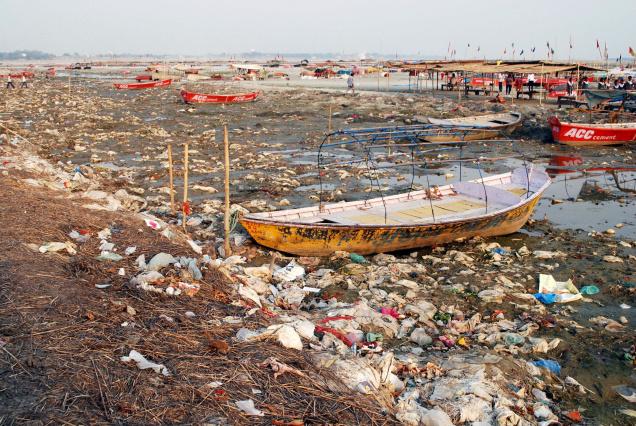Almost two months have passed since the largest human gathering, the Maha Kumbh Mela, concluded here, registering a mammoth 100 million devotees over 55 days. Huge banners and hoardings welcomed visitors to an eco-friendly, ‘Green Kumbh,’ spread this time over an extensive 4,000 acres.
While the Uttar Pradesh government receives accolades for its management of the mega event — most recently through a presentation invite by Harvard University — the Mela has left behind a trail of dirt and debris along the Ganga.
The banks of the Sangam are strewn with filth, flowers, pieces of earthen pots, leaf plates, polythene bags, excreta, shoes, clothes, plastic bottles, and other objects abandoned by the visitors. The retreating rivers have also left potholes on the banks, which are now breeding ground for flies and mosquitoes. “They [the administration] have deserted us,” says Brij Mohan Mishra, a priest, who like many others makes his living performing rituals at the Sangam. “With this mess around, how will things work? We have to clean the place ourselves. Where is the management now?” he asks.
Around 8,000 Safai Karmacharis or manual cleaning personnel, belonging to the Bhangi Scheduled Caste, were employed to keep the Kumbh area clean. During the main bathing days, especially the Shahi Snans or royal baths, they could be seen chasing down every piece of plastic bag carried by the wind anywhere close to the bathing ghats. However, since they left for their native villages in neighbouring Chitrakoot, Fatehpur, Banda, Mirzapur and Kaushambhi districts, the cleanliness drive seems to have deserted the Sangam.
“Mela Khatam, Safai Khatam [With the conclusion of the Mela, the cleanliness drive is also over],” says Ganesh Nishad.
For Chaundhihars or scavengers like him belonging to the Nishad caste, the waste left behind is a site for an unlikely treasure hunt. He paddles in the dirty water in search of coins or other valuables left behind by the devotees. At dry spots, the other Nishads are seen digging endlessly into the sandy banks with spades. “I’m not much concerned about the coins. If I get a gold necklace or ring, my labour will get saved for days,” says Ganesh.
At Daraganj, a locality on the banks of the Ganga and which formed the extreme end of the Mela, residents can only wait for the Monsoons to wash away the waste. Maujiram Bhind, 65, a veteran of many Kumbhs, says the amount of solid waste left behind this time was unprecedented. “The mela was larger, so the range of dirt has increased. From the Hanuman temple at the Sangam till the Nagavasuki Temple, there is polythene and excreta everywhere. And yet, no [mosquito] fogging has been done till today,” he says.
Further, during the Kumbh, all the city sewers were directed downstream of the Sangam to keep the bathing ghats free of filth. However, these sewer lines have once again been diverted into the river. With pipelines running alongside the accumulated dirt in the by-lanes, the residents are concerned with a major health scare.
“How do we know that these taps are not infected with dirty water? Every other day somebody is falling sick or complaining of stomach ache or vomiting. We fear we might have to face cholera or malaria,” says Guddu Nishad.
The vast amount of debris and dirt has also restricted the farming of the Nishads, who during summer cultivate cucumbers, cantaloupes and water-melons on the exposed sandbank. They are traditionally engaged in boating, fishing and sandmining.
Conceding the threats posed by the waste, Mayor Abhilasha Gupta said the administration would initiate a cleaning and fogging programme to prevent any health epidemics, with the support of NGOs, the Allahabad Municipality, the Health Department and the Army Cantonment, under whose immediate jurisdiction the Sangam area falls.
“Work could not start earlier due to cancellation of programmes. Those living close to the banks are the worst sufferers and by the first week of May, we shall start picking the polythene and move on to removing the dirt,” she said.
The Ganga Action Parivar, the force behind the Clean Ganga drive and the organizer of the ‘Green-Kumbh’ initiative, will also send a delegation to Chief Minister Akhilesh Yadav on May 10 for the initiation of a cleaning drive, said Ram Mahesh Mishra, Director of Parmarth Niketan of Rishikesh.
“The administration and various organizations can initiate drives, but the ultimate responsibility to keep the area clean lies with the devotees who came there,” he said.






























